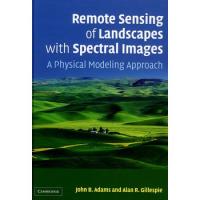| 定价: | ¥ 814 | ||
| 作者: | John B. Adams 著 | ||
| 出版: | 未知 | ||
| 书号: | 9780521662215 | ||
| 语言: | 英文原版 | ||
| 日期: | 2006-05-01 | ||
| 版次: | 1 | 页数: | 362 |
| 开本: | 16开 | 查看: | 0次 |

| 服务商城 | 客服电话 | 配送服务 | 优惠价 | 购买 |
| 400-711-6699 | 满29至69元,免运费! | ¥716.3 |
Remote Sensing of Landscapes with Spectral Images describes how to process and interpret spectral images using physical models. The emphasis is on the practical use of images rather than on theory and mathematical derivations. Examples are drawn from a variety of landscapes and interpretations are tested against the reality seen on the ground. A textbook and reference for graduate students and professionals in a variety of disciplines, it is supplemented by a web-site hosting digital color versions of figures and ancillary images .
About the authors
Preface
Acknowledgments
1 Extracting information from spectral images
1.1 Introduction
1.2 Field studies and spectral images
1.3 Photo interpretation of spectral images
1.4 Spectral analysis of images
1.5 Testing and validating results
1.6 Summary steps for extracting information
2 Spectroscopy of landscapes
2.1 Basics of spectroscopy for field investigators
2.2 Spectroscopy at landscape scales
2.3 Spectroscopy applied to images
3 Standard methods for analyzing spectral images
3.1 Initial evaluation
3.2 Calibration
3.3 Enhancement for photo interpretation
3.4 Data reconnaissance and organization
3.5 Physical modeling with spectral data
4 Spectral-mixture analysis
4.1 Endmembers, fractions, and residuals
4.2 Shade
4.3 Fraction images
4.4 Finding endmembers
4.5 Calibration feedback
4.6 Nonlinear mixing
4.7 Thermal-infrared images
5 Fraction images of landscapes
5.1 What to do with fraction images
5.2 Classification using endmember fraction Contents
6 Target detection
6.1 Spectral contrast and target detection
6.2 Detection limits
6.3 Spectral contrast and spatial scale
7 Thematic mapping of landscapes
7.1 Field maps and image-derived maps
7.2 Thematic mapping with spectral images
8 Processes and change
8.1 Process pathways in spectral images
8.2 Reference pathways
8.3 Mapping changes in landscapes
Glossary
Reference
Index
Preface
Acknowledgments
1 Extracting information from spectral images
1.1 Introduction
1.2 Field studies and spectral images
1.3 Photo interpretation of spectral images
1.4 Spectral analysis of images
1.5 Testing and validating results
1.6 Summary steps for extracting information
2 Spectroscopy of landscapes
2.1 Basics of spectroscopy for field investigators
2.2 Spectroscopy at landscape scales
2.3 Spectroscopy applied to images
3 Standard methods for analyzing spectral images
3.1 Initial evaluation
3.2 Calibration
3.3 Enhancement for photo interpretation
3.4 Data reconnaissance and organization
3.5 Physical modeling with spectral data
4 Spectral-mixture analysis
4.1 Endmembers, fractions, and residuals
4.2 Shade
4.3 Fraction images
4.4 Finding endmembers
4.5 Calibration feedback
4.6 Nonlinear mixing
4.7 Thermal-infrared images
5 Fraction images of landscapes
5.1 What to do with fraction images
5.2 Classification using endmember fraction Contents
6 Target detection
6.1 Spectral contrast and target detection
6.2 Detection limits
6.3 Spectral contrast and spatial scale
7 Thematic mapping of landscapes
7.1 Field maps and image-derived maps
7.2 Thematic mapping with spectral images
8 Processes and change
8.1 Process pathways in spectral images
8.2 Reference pathways
8.3 Mapping changes in landscapes
Glossary
Reference
Index





 粤公网安备 44030902003195号
粤公网安备 44030902003195号